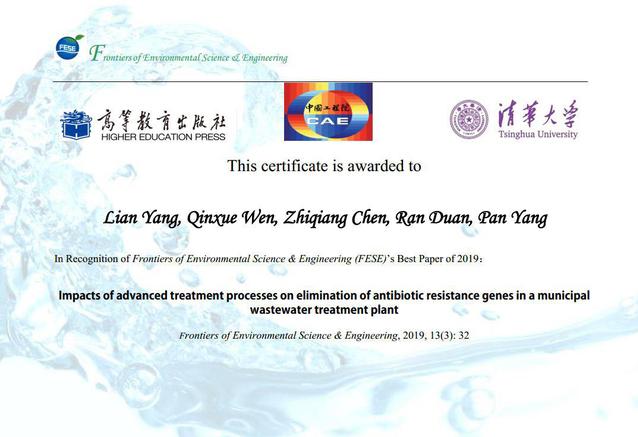Recently, Professor Chen Zhiqiang from School of Environment and the State Key Laboratory of Urban Water Resource and Environment of HIT made an important breakthrough in the reduction of resistance genes in urban sewage treatment plants. The research results show that the advanced treatment process combining biological treatment, ozonation and adsorption of amorphous granular activated carbon is a promising way to remove resistance genes and refractory organics from urban sewage, and provides a development direction for the control of resistance gene biological pollution in the effluent water quality of urban sewage treatment plant.
This research thesis, Impacts of Advanced Treatment Processes on The Elimination of Antibiotic Resistance Genes in A Municipal Wastewater Treatment Plant, was published in the international journal frontiers of environmental Frontiers of Environmental Science & Engineering (impact factor 3.883) was rated as the best paper in 2019. Yang Lian, a doctoral student of the research group, is the first author of the thesis, and Professor Chen Zhiqiang is the corresponding author of the thesis.
The overuse of antibiotics has become a worldwide problem. Its emissions will not only cause chemical pollution to the environment, but also induce the production of resistant bacteria and resistant genes. Among them, resistance genes are usually located in movable gene elements (such as plasmids and integrons), which can be dispersed in microorganisms through horizontal gene transfer, seriously endangering human and animal health. Wastewater treatment plants are considered to be an important barrier to prevent the release of resistance genes into surface water. However, most of the traditional wastewater treatment plants have limited ability to remove resistant genes, so the subsequent advanced treatment process should be considered to control the release of resistant genes in the environment.
In this study, the distribution of IntI1, 16S rRNA and six resistance genes in a sewage treatment plant in Harbin was studied for six months. At the same time, the removal effects of ozone oxidation and granular activated carbon adsorption on resistance genes in secondary effluent were analyzed. It was found that the change of resistance gene in influent during the study period was mainly due to the change of antibiotic emission. The absolute abundance of resistance genes (0.76-1.94 order of magnitude) was significantly reduced by the biological treatment of sewage treatment plant, while the removal effect of resistance genes by ultraviolet disinfection was not significant (less than 0.5 order of magnitude). The results showed that the removal of resistance genes increased with the increase of ozone dosage, and 60mg / L ozone could effectively reduce the resistance genes in secondary effluent. The results showed that the removal effect of the antagonistic gene was better than that of the granular activated carbon, and the adsorption of the antagonistic gene, the total organic carbon, the total nitrogen and the total phosphorus by the amorphous granular activated carbon operating continuously for 24~48h had good removal effect. The removal efficiency of resistance gene, TOC, TN and TP could be significantly improved by ozone oxidation combined with the adsorption of amorphous granular activated carbon.

Best Paper Honor Certificate of FESE in 2019


